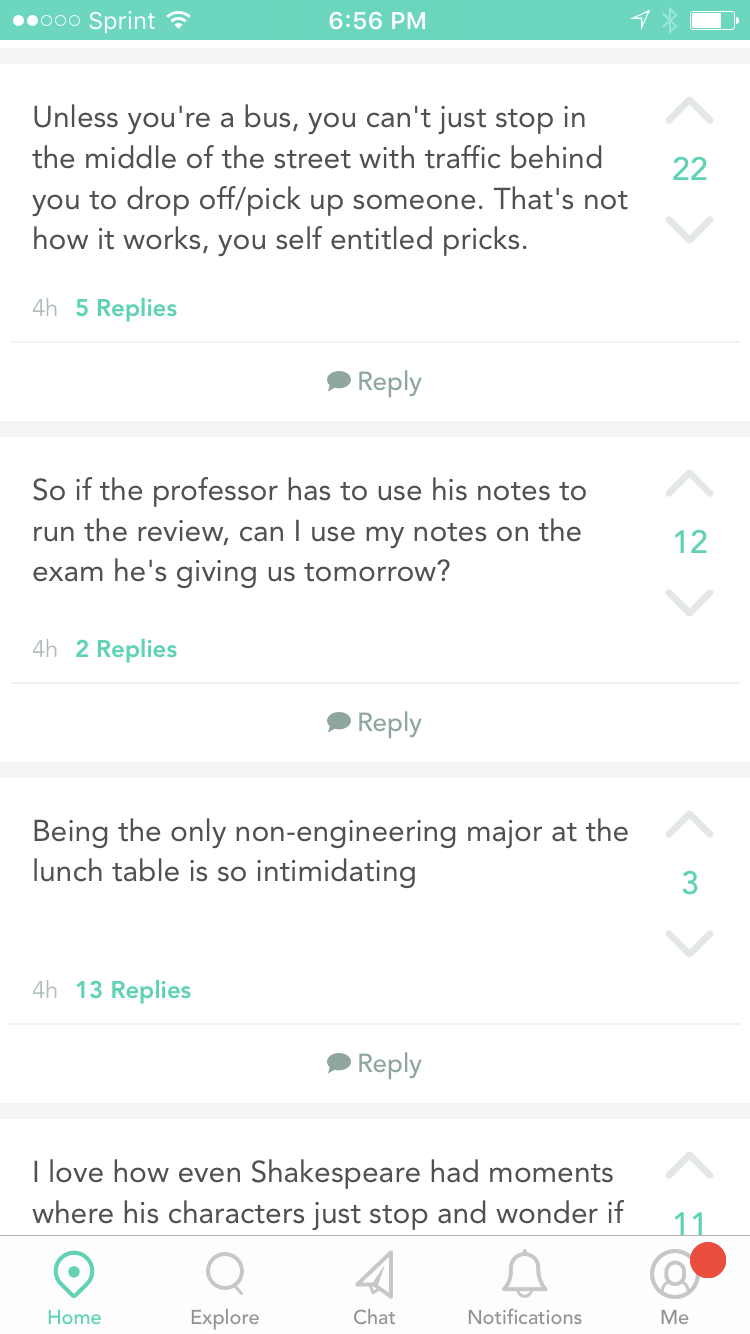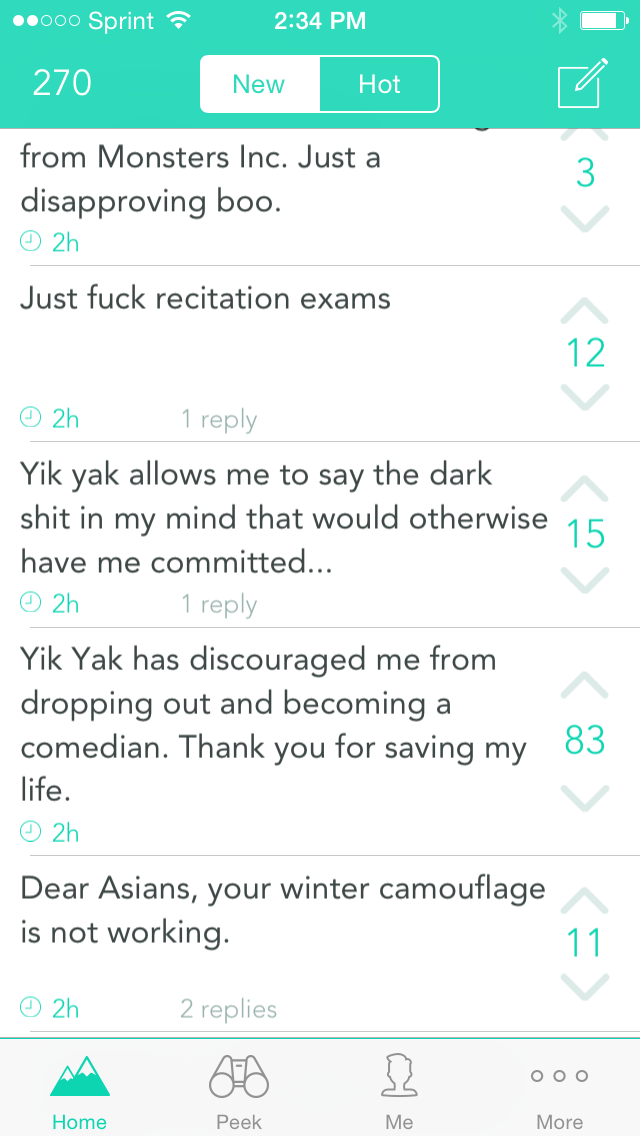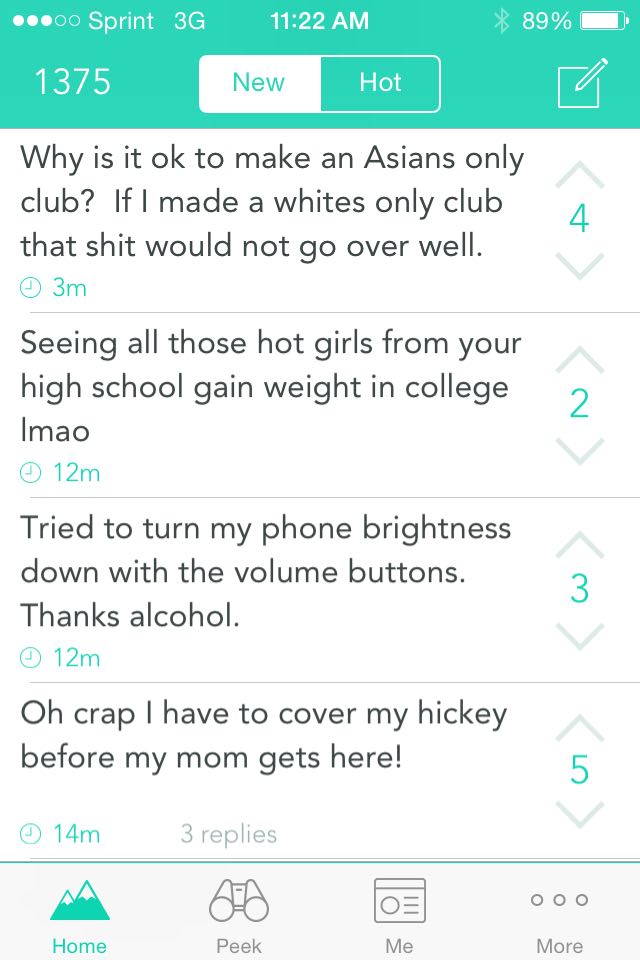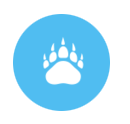
Yik Yak:
Learn the ins and outs of this anonymous application
This project positions Yik Yak as one example of an anonymous, place-based social media application. Instead of being organized around individual profiles and user-curated social networks, these locative-mobile (de Souza e Silva & Frith, 2010) applications determine networks according to geographic coordinates. Though such networks are limited to users within a particular physical area, the absence of personal profiles and the low threshold for entering networks (merely by being in a particular physical space) facilitates a dynamic environment for students to engage, emphasizing the functions of time, place, and feeling (relatedness and interruptions in relatedness) in composing processes.
Features of Yik Yak
Created for and marketed towards college students, Yik Yak (see example of Purdue's feed from Spring 2016 below, right) gave users a glimpse at the conversations happening around them as they unfolded, allowing them to keep their identities secret as they engaged in these conversations. Users could post their own content and interact with others through comments, upvotes, and downvotes on posts, commonly called "yaks." When a user posted on their local Yik Yak feed, their post showed up at the top of the feed. As time passed and more posts appeared on the feed, older posts moved towards the bottom. This process was able to be slowed down if a particular post received a lot of upvotes (or sped up, if users downvoted a post; more than 5 downvotes resulted in a post disappearing completely from the public feed). Eventually, however, all posts would disappear from the main feed, ans were only viewable by their original author under the "My Yaks" section of the application.

When the first version of Yik Yak was released in November 2013, users could only read and post on threads created by other users within an immediate geographic radius of 1.5 to 10 miles (the radius of the network varied according to population density). Updates to the application expanded that original functionality a bit: soon after its initial release, users were provided with the capability to "peek" at feeds from other locations, but not post; in May 2015, users could set their "My Herd" location, which allowed them to post from afar on their one designated local feed. Additionally, Yik Yak offered general feeds that users from any location could access and post to as well, organized around trending topics or current events. These updates provided more options to users, but the application never lost its primary focus on local networks, partially due to the application’s default display of one’s local feed. This focus on locality undoubtedly contributed to the application’s success on college campuses.
The anonymity of the application was perhaps its most discussed feature: when it was first released there were no options for handles or usernames. Upon downloading the application, users provided their phone number (never accessible to other users, just Yik Yak staff in case of legal issues). Several years later, when I used this assignment in my first-year composition class, users had the option to use handles, which could be changed with every new post. The last year and a half of Yik Yak’s existence, profiles were associated with permanent usernames, but a user could choose to hide their username on their posts (and most did); further, the profile pages of users never had a space for interactions between users, or allowed for much customization (only allowing for a picture and a link to another form of social media). Clearly, developers infused some more familiar social media characteristics into the application (assumedly trying to keep it relevant), but the optional nature of these features allowed the application to continue being utilized much as it was when it was originally released—as an anonymous, location-based message board.
It is important to note one more aspect of the application: there were no moderators, as there are with traditional message boards or online communities. Instead, the application was designed to be self-policing, as users could either downvote posts they deemed inappropriate, or report posts that were threatening or revealed personal information (like phone numbers or addresses) for immediate removal.
Yik Yak in the Public Eye
Below are several screenshots of Purdue University’s feed, taken during the Fall 2014 semester, and while many posts are lighthearted, more than a few reveal some unsettling attitudes towards particular groups—including "Why is it ok to make an Asians only club? If I made a whites only club that shit would not go over well," aggressively framing difficult questions about race and privilege, as well as the ominous, "Girls know what they’re getting into when they put on those yoga pants," suggesting that women are responsible for inappropriate male attention directed towards them.
![Screenshot of Yik Yak feed, Fall 2014. Posts include, 'I wonder if Asians have their own form of yik yak that they slam on Americans in,' and 'Girls know what they're getting into when they put on those yoga pants,' and 'The delivery guy for the condom deliv [sic] service officially has the worst job on campus.'](images/yik2.jpg)


Posts like those featured above were unfortunately not rare on Yik Yak, as evidenced by the many controversies surrounding the use of the application. After reports that the app was being used in service of cyberbullying in high schools and middle schools, Yik Yak developers created a geo-fencing system which blocked use of the application in between particular geographic coordinates. Though this system did decrease the use of the application in younger populations, problematic posts were still found on college feeds. Several universities publicly discussed the application and even banned it, including Lewis & Clark College and Emory University (House, 2014; Rosenfeld, 2014). The College of Idaho and Emory University both submitted geofence requests to Yik Yak (Orenstein, 2015; Shamma, 2016). Yik Yak never acquiesced to any university or college request for a geofence, stating on their website that, "We only geofence middle and high schools (primary and secondary) and will not geofence an entire town or college campus."
Adding to its controversial presence, Yik Yak was used to threaten violence at schools in California, Michigan, and Iowa (Milanes, 2014). These users were all apprehended by law enforcement, because Yik Yak staff released phone numbers and IP addresses in these situations (an outcome users acknowledged when they agreed to the terms of service after downloading the application). Though the developers of the application undoubtedly were required to respond to these situations, more common scenarios, where individuals found themselves being harassed by anonymous users on the application but not directly or physically threatened, created more complicated situations—situations that students noted throughout this study. This points to the potential ethical value of assignments that incorporate anonymous social media applications, or even applications like Twitter, which assuredly have problems with online harassment.








